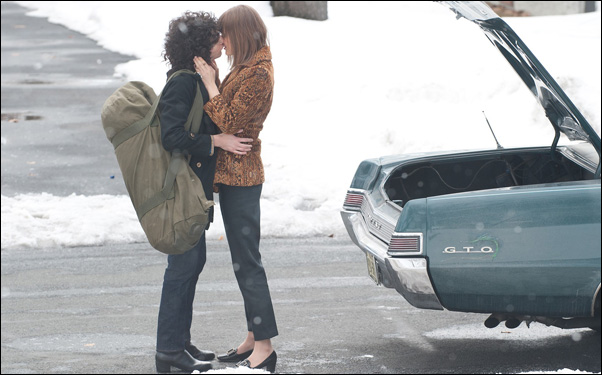It was en route to the Paramount Theater for the opening night of the Austin Film Festival that I caught my first glimpse of the poster for “Not Fade Away,” fronted by a sexy, nostalgic snapshot of two kids whose lips are pressed so tightly you almost can’t make out their faces. The image is provocative for many reasons, and perhaps more so after one has seen the film because while fabled “Sopranos” creator David Chase’s first foray into film is indeed a love story, it’s not between a guy and a girl, but rather a guy and rock ‘n’ roll.
That these two things have to be mutually exclusive in order to endure is one of the mildly radical ideas lobbed out by the writer/director in the story of thousands of young men in the suburbs in the ’60s who picked up guitars upon hearing the twang of “A Hard Day’s Night” for the first time told through the journey of one named Douglas (John Magaro) who grows up in Chase’s beloved working class milieu of New Jersey. Chase has dismissed that the film is autobiographical in any way, nearly as quickly as the fictional Douglas’s sister dismisses her brother with the Bob Dylan bouffant’s attempt at rock stardom in the film’s opening narration, shutting the door on the more traditionally celebratory look at a culture escaping Eisenhower-era conformity in favor of a more abstract walkabout for Douglas where there are no rules to what he can do in life or in his band, but also no clear path to professional or personal success.
However, “Not Fade Away” is clearly personal to Chase, who stuffs the film with fetishes and feels, not all of which make total sense in a narrative context, but undoubtedly give the film a warm authenticity that compensate for its chilly central character. Despite being positioned as uncool at the start, everything seems to come pretty easily to Douglas, from his rise to lead singer in his group after being buried in back with the drums to the not-so-conspicuously named popular girl Grace (Bella Heathcote) he’s longed pined for who naturally falls into his arms once he’s a frontman.
In contrast to the rebellious vibe of the bands on the rollicking soundtrack put together by Sopranos star and E Street Band’s Steven Van Zandt, Douglas’s path is mostly one of least resistance, willingly disconnected from his father (James Gandolfini, who quietly does a nice job with some of the film’s heavy lifting) and prone to tuning out anything but the blues, Dylan, or the Kinks. His only brushes with misfortune are the stories he hears from his black co-worker (Isiah Whitlock Jr.) at the country club, whose stories of the civil rights movement barely draw his interest, and his father’s eventual pleas to help take care of the family, which conflicts with his plans to head to California with Grace.
Heathcote doesn’t have a lot to work with once Grace becomes Douglas’ girlfriend, asserting her independence frequently as a character, but with the film not allowing her enough time to break free, allowing more of an arc with her fully radicalized sister than with Douglas, which is a shame because following a standout turn in “Dark Shadows, it’s clear those big eyes of hers aren’t the only way she can seduce an audience. As written, however, her feminine wiles still are no match for the raw energy of a great guitar riff (something Chase acknowledges directly in one of the film’s signature moments of silent reactions to the Rolling Stones rocking on Dean Martin’s “Hollywood Palace”) and while it’s at the expense of a more satisfyingly complete picture, the passion that runs throughout “Not Fade Away” is infectious, wasting no time getting into the bloodstream with an opening audio trick involving the bass line to “Satisfaction” that is as shrewd as any moment from Chase’s illustrious television work.
As a first-time feature director, Chase is still finding his rhythm, cross-cutting between scenes at such a rapid clip sometimes that it can feel cannily impressionistic or clumsy, with longer, richer scenes such as Douglas’ father dinner table rumination about paths not taken there as a reminder that other avenues, particularly the film’s allusions to the social issues beyond Douglas’s purview, aren’t as fleshed out. Though Grace is there to remind Douglas that “Time is on your side,” Chase may have felt differently, his craftsmanship evident in pushing the story forward with every technical ability available to him and every frame he’s afforded, but compromised by having less of them to work with than in his other medium. Still, there’s an inherent understanding of the magic of the movies, resulting in a style that visually may run more towards the cool remove of “The Sopranos” and tonally resembles the quirkiness of “Northern Exposure,” but ultimately finds its own place between nostalgia and something new and unusual. Make no mistake about it, Chase’s entrance into films is a welcome one with “Not Fade Away” likely being as formative an experience for an artist in search of what’s next as the story told onscreen.
“Not Fade Away” will be released by Paramount Vantage on December 21st.




